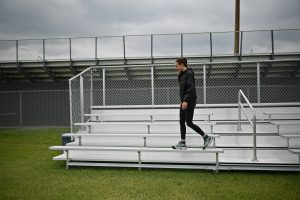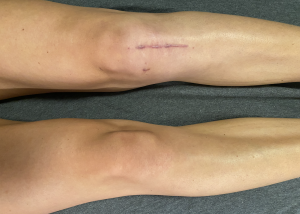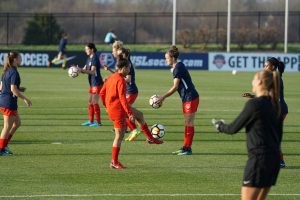Court Sports and ACLR
Basketball is a sport that commonly has ACL injuries due to the jumping, landing, pivoting and change of direction associated with the game.
The ACL rehab process won’t necessarily change between sports in the beginning phases as the focus is on range of motion, managing swelling and pain, and getting walking patterns back.
The sport aspect can start to make its way into rehab in exercises like balance where you might have the patient dribble the ball in a semi squat position, or balance exercises with a throw and catch. Eventually this can be added to running drills when you want the patient dual tasking, and definitely when you start getting more sport specific.
I spoke with Haider, a certified sports physiotherapist in Toronto and the head physio for the CEBL Scarsborough Stars basketball team, about rehabbing court athletes since he is also going through his own ACLR rehab journey at the moment.

What are 1-2 key differences you think court/basketball athletes in mid stage rehab and/or end stage rehab need to cover more than other athletes?
A couple of the key differences in basketball boil down to asking these two questions:
1. What’s the environment like?
Usually, ACL injuries in basketball occur while the player is on offense, in the paint where it is crowded, and there is often an element of contact in the upper body on the contralateral side to the planting and subsequently injuring limb.
2. What is biomechanically happening?
The injured limb tends to contact the ground during deceleration outside of the player’s base of support. This often occurs either during the 1-2 step after picking up their dribble and planting or as they are attempting to absorb a landing after a jump.
I do my best to consider the sport and reverse engineer the rehab process with that in mind. So, for my basketball athletes, I turn to the research to tell me how these players normally tear their ACL. This informs my rehab process as I aim to use these compromising positions to develop movement competence so the player is in a position where they can succeed.
What is a technique(s) you use during your rehab for patients that is specific to basketball?
This isn’t specific to basketball but communication.
I understand it’s not a very specific “technique,” but I believe communication with the athlete, their support system, and coaches/trainers is critical. Depending on the level of competition, numerous factors come into play, and maintaining efficient and open lines of communication with all involved parties is one of the most powerful tools in your rehab toolkit.


How do you manage the mental aspect when athletes are back on the court for the first time?
The mental aspect is incredibly critical, and without addressing it, you might overlook a key component of rehab. The first step is to establish trust with your athlete. Since the rehab process is lengthy, building trust throughout is essential so they can buy in to your plan.
Secondly, it’s crucial to be very intentional with your approach so that you gradually and progressively challenge the athlete. This allows them to gain confidence from the wins they accumulate during rehab which ultimately encourages resilience from overcoming obstacles and shows them that they are ready for the next step.
Finally, I make use of patient-reported outcome measures such as the Tampa Scale of Kinesiophobia, ACL-RSI, and IKDC. These tools are great in guiding my clinical decision-making regarding the athlete’s psychological readiness.
You’re currently going through your own ACLR rehab – share the run down of when/how the injury happened, your surgery experience and where you’re currently at in the rehab process.

In January 2023, while playing basketball, I drove to the net and took a hit while I was in the air, which knocked me off balance. As I was on my way down, the area was crowded, and I didn’t get to land properly. I felt the shift in my knee as I hit the ground and I knew right away that I tore it.
I saw my orthopedic surgeon and then an MRI confirmed what I already knew. I decided to delay surgery for a year and see how far conservative management could get me. Either I’d be feeling great and can avoid surgery, or if I still didn’t feel 100%, at least I’d have the opportunity to develop strength which would serve me well post-op. I made it fairly far, but as I wasn’t feeling like I was fully there, I decided to go ahead with surgery.
My surgical experience has been smooth so far, thankfully! The surgery itself went great. The initial recovery was extremely humbling once you feel how hard it is to do the smallest things like lifting your leg to get out of bed. As a physiotherapist, I took the first month off clinical work and focused on getting myself more mobile and stronger in order to get back into the clinic and look after my own clients’ rehab.
Since the initial recovery, the biggest learning experience for me has been remaining consistent. Life can get busy, and prioritizing your rehab can fall off here and there, but remaining consistent is key! I’m 4 months in now and I’ve come a long way since January, but I still have a long way to go too.
Are there aspects of the ACLR rehab process so far that you didn’t anticipate even though you are a physio and have treated ACL injuries?
Mainly, the initial process of recovery. Especially the quad inhibition (read more about this). I’ve rehabbed so many people after surgery and you always work on quad sets early on and notice how difficult it is after surgery to get that guy to fire. But then going through it myself was such an interesting experience. I’m definitely able to empathize with my clients now on the little things like that.
I think as a clinician, it is such a rewarding experience, being able to work with motivated individuals as they work towards reaching their goals. Going through the ups and downs with them and then finally getting to the stage where they are back out there on the court doing what they love is one of the best feelings you can have as a clinician.
Management of ACL injuries has come a long way, but with the incidence rates still high and prominent in all levels of the sport, I look forward to our knowledge and understanding of the injury evolving, along with our management approaches.

Haider Tirmizey, MPT, FCAMPT, Sport Physiotherapy Certification
Regional Lead Clinician Myodetox
Head Physiotherapist for Scarborough Shooting Stars
You can follow Haider on Instagram or if you live in the Toronto area, you can book with him at Myodetox.
Follow along the Scarbourough Shooting Stars CEBL team as they start their season this month looking for back to back championships!
Grab the ACL Injuries eBook if you have just injured your ACL.
Reference:
Gill VS, Tummala SV, Boddu SP, et al. Biomechanics and situational patterns associated with anterior cruciate ligament injuries in the National Basketball Association (NBA). British Journal of Sports Medicine 2023;57:1395-1399.


